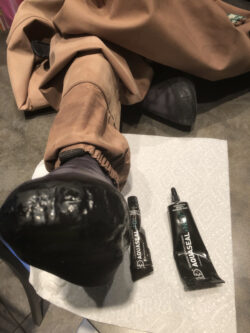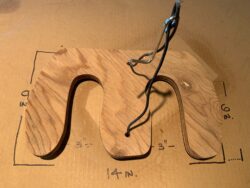Some anglers just need to wet wade since no boots are ever going to stay waterproof on their bodies. It doesn’t matter what company makes them, how thick they are, what material is used, some people are just Boot Destroyers.
Sharp sticks/ rocks, barbed wire, pointy edges, briar patches, clumsy fallers, or just careless fishermen can ruin a brand-new pair of waders in moments. As boots become better quality, they also become more expensive. $500-$800 are not uncommon.
When Montana Grant was a young buck, dry boots were a problem. My boots constantly had holes, tears, and leaks. I also had a knack of going too deep and overflowing. My feet and toes were constantly wet and cold. There was no root I wouldn’t trip over, no sharp stick I would not stab, or no barb wire that I missed. I was the King of the Boot Rippin Boogie!
Here are some tips for better booting!
Get fitted properly. You get what you pay for when getting boots. Large fishermen often wear boots that are too snug and small anglers are fitted to lose.
Neoprene These boots fit snuggly but flex with your body. If the boots are too tight, they will accentuate every curve. Special gels and seals work well for repairs.
Rubber Old school rubber and canvas waders can be patched and sealed using Lexel or other repair gels.
Fabrics Gore-Tex and breathable fabrics can be sealed with Aqua seal or Flex Seal. 
Boot foot or stocking fit Boots are durable but can still get holed. If the hole is in the heel, toss the boots. If you get a stocking foot wader, you need slip on boots. It doesn’t matter if the boot leaks. You only need to fix the waders.
Hip, Waist, or chest. Think about where you fish. The older and more unstable you are means you should get hip boots. Deep water is not your friend. Never venture more than 2/3 the height of the boot top.
Zipper fly fronts new zippers will not leak. These make removing wader easier. Bathroom use is quicker with a zipper.
Care and treatment Dry and air out wares after each use. Make an inverted boot hanger or use a blow dryer. Crumbled newspaper will also draw out moisture. Large silicone moisture bags also work well.
Quick repair Once the water leaks in, your day could be over. For a quick fix, try using super tape to seal the hole. Make sur ethe area is dry, then apply. This is true with most quick repair sticks and products. Once the day is done, make a proper repair. Silicone sealants like Lexel, make great repairs but take time to dry. Flex Seal comes in clear and works well. Whatever repair you use, make sure that the boots are dry to start. Age the repair overnight, 6-8 hours.
To Locate a leak Spray alcohol on breathable fabric and Gore-Tex. Leaks show up as black spots. Make visible inspections for obvious tears and punctures. Examine seams. For other boots, hang up and fill with water. As a leak appears, mark with a grease marker. Dry and repair.
Wade shallower not deeper Just because you are wearing chest waders does not mean you need to wade chest deep. 90% of most fishing is ankle to knee deep. Once you wade deeper, you become buoyant and begin to lose contact with the bottom. This is when you fall and submerge.
Traction soles. Old school boot traction came from old carpet and glued on felt. Many states now outlaw felt since they can carry eggs from invasive critters or plants/algae. Aluminum chains, cleats, and studs really help. Other specialized Vibram style soles also help.
Watch where you are going. Anticipate what will tear your boots. Usual holes end up in the ankles, knees, and crotch. Many of these tears and punctures are preventable. Knees blow out when you fall. Avoid tripping and stumbling. Use a wading staff to keep your balance. Collapsible staffs store out of the way and are in a holster when needed. Longer staffs can simply be attached to a cord and float behind you.
Floatation is smart. If you are a poor swimmer, wear a compact safety harness that can inflate in an emergency.
Under wader gear. Compression pants and fleece pants are awesome for comfort and keeping your muscles, circulation, and support intact. Yoga pants work well. Better circulation means warmer legs. Wear socks that wick away moisture from sweat or condensation.
Sadly, older, and damaged waders will eventually become unreliable. You get what you pay for with waders. Cheapo waders leak faster than better quality ones. Quick repairs are temporary. Treat yourself to some new boots every few years. Use the leakers as back ups or hand me downs.
Stay dry and warm!
Montana Grant